Eploring the culture of Dominica through communication
Don't wanna be here? Send us removal request.
Text
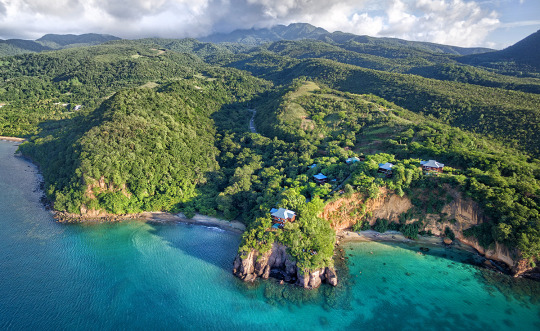
For today’s blogpost I have been asked to consider how well I would adjust to spending time in Dominica, from a weeklong vacation, all the way up to living there for a year or more. This is an exciting prospect to consider, though I don’t know what circumstance would lead to me being able to do so.
I am reasonably certain that a short visit of one or two weeks would not require much adjustment on my part. After all, Dominica has a growing tourism industry and has many beautiful sights to see and places to go. If I were planning to stay for as long as a year or more, I would need to look harder at the experiences of daily life on the island. I know I could prepare by studying up on the local Kweyol language, which can be done by reading Kweyol Donmnic. It is also a good idea to familiarize yourself with the national holidays and what they represent. I would also want to spend more time speaking to my friend about what to expect and what behaviors I would need to be aware of that might cause confusion or discomfort should I not react appropriately.
The most important thing for me to remember would be that I am interacting with Dominican culture from a position of ignorance. The way I behave and interact with the people I meet will be subject to their values and it is not up to me to decide if something I might do is offensive. I was fortunate enough to have been raised to treat others with respect in my daily life. One of the most important interpersonal skills my parents taught me was this, if you don’t know why somebody is doing something ask if can ask them about it. By doing that you place the power of the conversation with the person you are approaching, which allows them to teach you rather than correct you.
The easiest way to connect with new people is to talk about something you have in common and here I have a distinct advantage. I spent more than a decade as a professional chef and if there is one thing people like to talk about, it’s food. Everybody has a favorite dish, a secret family recipe, or a family member that cook in a way that just can’t be replicated. Talking about food helps people find a relaxed mood opens up avenues of conversation that wouldn’t be possible otherwise.
While I may never get the opportunity to visit Dominica in person, I know that if I ever do I will happy that I took time to learn about the people and history of the island.
0 notes
Text
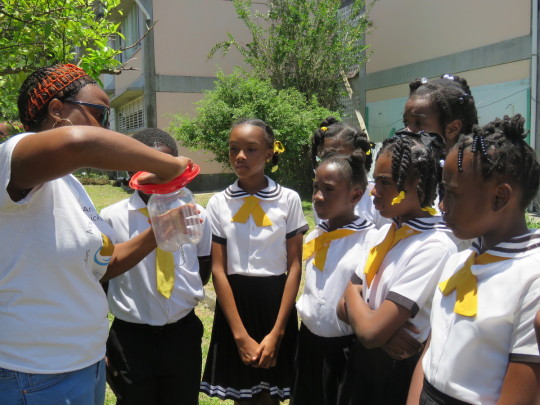
Hello everyone, this week we will be looking at the basics of the education system of Dominica. Primary and secondary school are public resources in Dominica, with school attendance being compulsory from ages five through seventeen. Unfortunately, I wasn’t able to find any information on graduation rates, or statistics on continuing education. I was able to find out that completion of secondary education (high school) is done by passing a standardized test, administered by the CEC (Caribbean Examinations Council) which is the joint governing body for most Caribbean nations.
This link will take you to an overview of the education of 2009, that was published in 2020. It provides a few statistics about enrollment in primary and secondary education, as well as the names of the post-secondary schools within the Caribbean region.
This link will take you to a different overview that describes the number and types of schools, and the basic grading system.
Outside of that I couldn’t find any real information about the daily life of students, other than official government channels.
This link shows a video about the way the Dominican education ministry is dealing with the continued risks of covid-19 in classrooms from earlier this year.
Sadly, that is all I could find as the rest of the links were all for expats, people seeking to obtain citizenship through investment, or those seeking to attend nursing school from African nations.
0 notes
Text
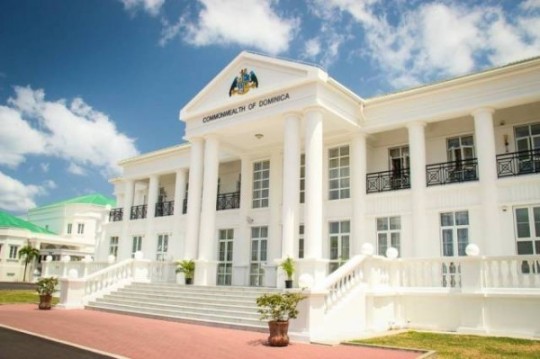
This week we are taking a look at communication within the context of business and the practical differences between the culture of Dominica, and that of the United States. I spoke to my Dominican friend about this and he said that business there is the same as business here. The Primary difference is that open air markets are still a standard practice in Dominica, much like other cultures that emerged after the end of colonialism. This is a recent video I found of a Dominican family trip to the market, https://www.youtube.com/watch?v=1aRPk1mvusU&t=25s
In more formal business settings are much the same with a little more small talk. People are expected to dress in accordance with their station in their industry. Professional dress ranges from a full suit and tie to khaki pants and a polo shirt if there is not a specific uniform required. Though, as always it is common for Dominicans to incorporate the traditional plaid patterns into their daily dress.
Greetings are cordial, a firm handshake while looking your counterpart in the eye. It is customary for the person receiving guests into there place of business to initiate conversation. Starting with good morning or good afternoon followed asking after the visitor's day is the common practice in both countries. Corruption in both the private sector and government operations is another cultural aspect that U.S. Americans share with Dominicans, and so we have similar ideas about gift giving and its association with bribery.
Some of the potential issues that you may find, should your career lead you to find yourself in Dominica, is that the local accent can be quite heavy with some people. Also, in the smaller towns and rural areas many of the people will prefer to speak Creole or Patois. Last, you will find that Dominicans tend to behave more rigidly around foreigners, which is another trait common to small nations or cultures with their roots in colonial history.
As I have mentioned before, I had the pleasure of serving in the army with a man, Rama Toulon, who was raised in Dominica. He never had a problem with adjusting to life on the continent or working in the U.S. American culture. The greatest difficulty he had was in the fact that he more emotionally mature and bookish than the majority of our fellow soldiers, which is why he and I ended up being such good friends.
0 notes
Text
Nonverbal communication
Today we ae going to be looking at nonverbal communication practices by comparing the people of Dominica with other cultures, Mexico, and The United States. Nonverbal communication transmits information about your internal states such as mood, alertness, distress, and even if you are hungry; whether or not that communication is unintentional. It also serves as a way to project your personal identity toward others without having to speak to them.
Nonverbal communication first consists of our body language, our posture, how much we move our hands when we talk, fidgeting, facial expressions, eye contact, physical touch, substituting gestures for words, and physical distance from our conversation partners. Second, we carry messages about ourselves in the clothes that we wear, how they are worn, and relative to the situation we are in. It also includes our breathing patterns and the frequency, and duration of the times we choose to remain silent. These things, contrasted with the context of the environment, and social situation, are used to gage whether a person is behaving appropriately.
I watched this documentary, The iD Project | Full Film, about a British born Dominican going to the island to better understand his father, his family, and his heritage. I chose this film because it highlights the culture of Dominica as it is seen by Dominicans, and is not directed at, or made by tourists.
You can see throughout the film that the people of Dominica dress in a combination of traditional and western contemporary fashion. Much like in Mexico and the United States, adults dress more formally depending on their professional station, occasion, and current activity, while children are dress mostly for play, unless they are going to church or a specific function. The women of Dominica seem to be as likely to wear a dress made of traditional plaid fabric as one of a single color, while the men like to wear vests, ties, and sashes, of the same style for formal and cultural occasions. This is similar to dressing in the Durango style of northwest Mexico, and the southwestern United States, with traditional Mexican dresses for women, and bolo ties, and cowboy hats and boots for men.
The similarities of these three cultures continue with body language. Each group is more likely to become physically animated when they are speaking about something they are passionate about, unless the social situation they are in would make that inappropriate. One of the main differences between the cultures is that Dominicans seem more comfortable with casually touching, but, I think, that is due to the small size of their population.
Lastly, The Dominican people seem to be the most relaxed when it comes to the idea of time. Dominica and Mexico both have a majority Catholic population, which means that they are strict when it comes to punctuality for religious observances. Each of the three cultures have similar ideas about punctuality when it comes to business as well. However, Dominicans and Mexicans are more relaxed when it comes to social situations and being on time.
All told, these three cultures are more alike than they are not. Each has its own unique attributes and many more that are shared, we are all human after all. From what I can see, the main differences in these cultures are driven by population diversity and size. With a population of around seventy thousand, Dominicans enjoy a greater deal of familiarity than either Mexico or the United States.
0 notes
Text
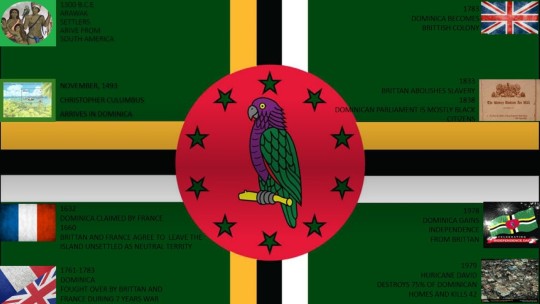
Some of the more culturally formative events in the history of Dominica are, the agreement between Brittan and France to leave the island unsettled, the repeated conquest of the island during the Seven Years War, and the abolishment of slavery in 1833.
The agreement by Brittan and France to not settle Dominica allowed the native population to continue to thrive and grow as Caribs displaced by colonization and escaped slaves moved to the island seeking freedom. Being a haven for these groups created a diverse culture with a common experience of seeking independence from European influence. This phenomenon continued throughout the colonial period of the Caribbean regardless of which nation claimed or controlled the island.
The repeated conquest of Dominica during the Seven Years War created a period of turbulence and insecurity for the European slave holders but would have had little direct effect on the enslaved and native populations. The lasting effect of this conflict was the transference of control of the island from the French to the British, while these nations had similar policies toward native and enslaved populations, Brittan had a more stable central government during late 18th and early 19th centuries.
The abolition of slavery drastically altered the course of development for Dominican culture. The ability to participate in government by the greater portion of the population laid the groundwork for the later independence movement.
Here is a link to a short but entertaining video about the history of Dominica
youtube
0 notes
Text

Hello all!
In today’s post we’re going to talk a little about Dominican families and how they interact with the world around them. I asked my army buddy if he could tell me about how families work in Dominica and this was what he told me, “Family structures in Dominica and the Caribbean are very tight. While not as common practice now as it was in the time of my grandparents, but having outside kids was not unheard of. There is great respect for older relatives. Family raises family. I spent a good portion of my youth - I helped raise my siblings.”. Like many cultures with a colonial past, Dominican families are influenced the parts of European cultures left behind when they gained their independence. Like how the structure of the nuclear (two generation) family is considered to be the norm in Dominica as well as the United States.
One of the most prominent institutions from European culture that became engrained in Dominican culture is that of religion. My friend also said that most Dominican families are, “Deeply religious - Catholic etc.”. According to https://www.indexmundi.com/dominica/religions.html the population breakdown by religion looks like this, “Roman Catholic 52.7%, Protestant 29.7% (includes Seventh Day Adventist 6.7%, Pentecostal 6.1%, Baptist 5.2%, Christian Union Church 3.9%, Methodist 2.6%, Gospel Mission 2.1%, other Protestant 3.1%), Jehovah's Witness 1.3%, Rastafarian 1.1%, other 4.3%, none 9.4%, unspecified 1.4% (2011 est.)”.
Since we were talking about European influences, I asked him if it was common to speak English or was that mostly people in the service industry. He told me, “Most families speak The Kings English and Patios (Haitian French).”. It’s also important to point out that there are several thousand Kalinago people that speak their native language.
The last question I asked him was how common it was Dominicans to emigrate like he did. He said, “Migration happens mainly with younger kids who don't have a ten-dollar surname (colloquialism for rich family) will often excel in school in order for better educational opportunities.”.
After talking to my friend, I figured out that there plenty of things our cultures have in common when it comes to family and the big differences are found in other places. Practicing religion is very common in both our back grounds, though the mix is a little different. Family is an important part of how each of us grew up and helping take care of younger siblings is considered a normal part of that.
The typical Dominican family functions in a way that reflects their cultural past. The family unit consists of parents and their children, with extended family nearby. People are expected to be married when they have children, but it is not uncommon to do so otherwise. Finally, most Dominicans have the same religion as their parents, they speak the languages their parents taught them and if they do leave their family behind, it’s usually to find a life that fits them better.
0 notes
Text
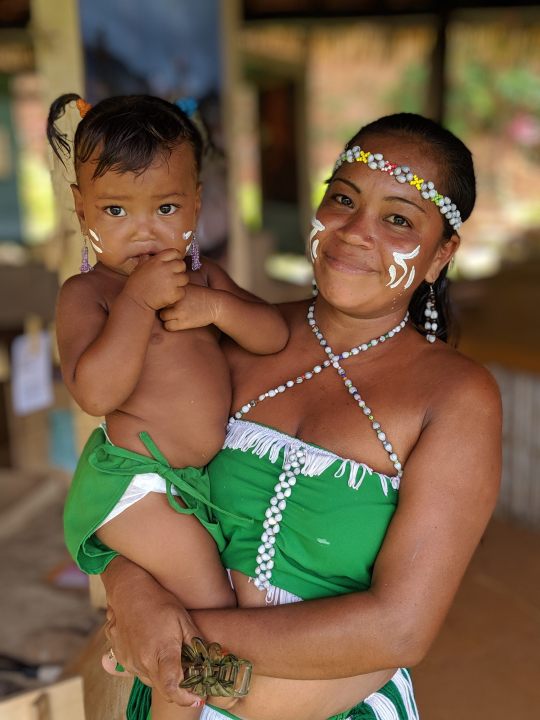
Kalinago mother and daughter, Dominica, by reportagestourisme
210 notes
·
View notes
Text
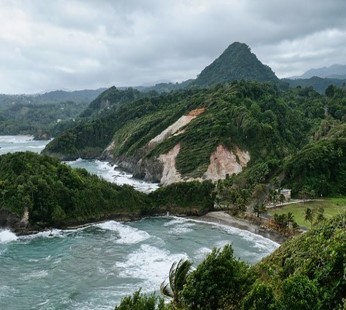
Dominica culture is comprised by the influences of the indigenous Carib people(also known as the Kalinago people), French and English colonialism and the West African cultures that were brought to the island through victims of slavery. One of the first and more important things you will learn when talking to a Dominican is that while they spell the word the same way as a person from the Dominican Republic it is pronounced differently by putting emphasis on the second “I” rather than the first( Do-min-Eeka or Do-min-Eekan). Another point of pride for Dominica is that it was the last island to colonized by Europeans, do largely to the resistance of the Kalinago natives.
1 note
·
View note
Text
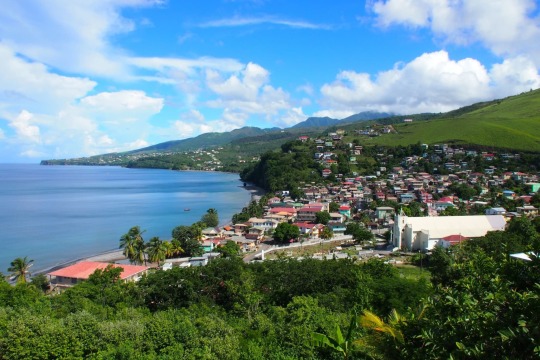
Dominica culture is comprised by the influences of the indigenous Carib people(also known as the Kalinago people), French and English colonialism and the West African cultures that were bought to the island by victims of slavery. One of the first and more important things you will learn when talking to a Dominican is that while they spell the word the same way as a person from the Dominican Republic it is pronounced differently by putting emphasis on the second “I” rather than the first( Do-min-Eeka or Do-min-Eekan). Another point of pride for Dominica is that it was the last island to colonized by Europeans, do largely to the resistance of the Kalinago natives.
1 note
·
View note
Text

Today I start my journey into the culture of Dominica. I chose this place and its people because of an old friend from my days in the army. He told stories about the colorful celebrations and gigantic street festivals, his days spent in the forests with friends and family and, the special fishing trips with his father. My hope is that by speaking to my friend while doing my research will help me better understand small details and nuances of the rich and diverse culture of Dominica more deeply.
1 note
·
View note